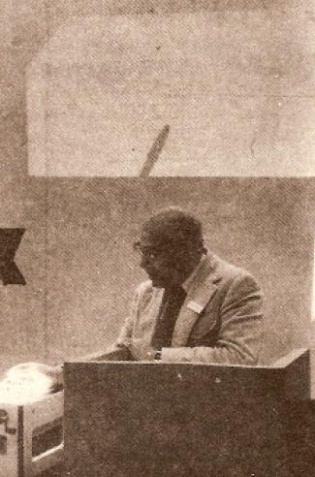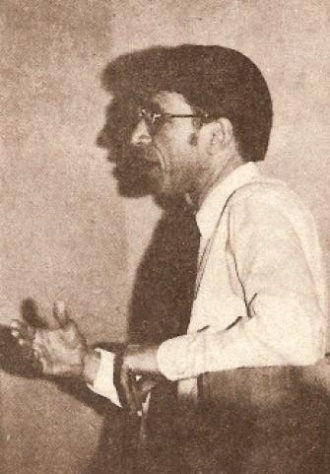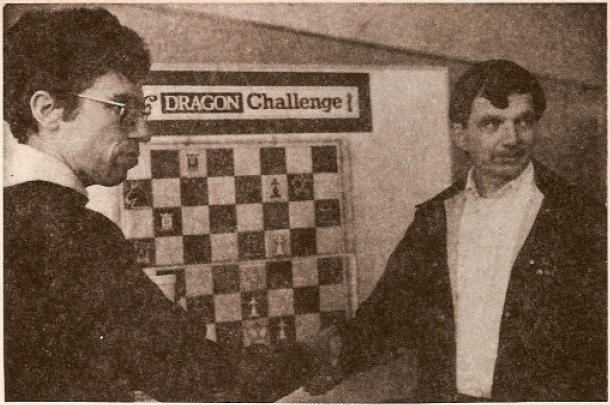Advances in Computer Chess 4
Home * Conferences * Advances in Computer Chess 4
The Advances in Computer Chess 4 conference was held at Brunel University, Uxbridge, West London, UK, on April 17-18, 1984. Chairman of the conference as well as editor of the conference proceedings was Don Beal.
Proceedings
- Advances in Computer Chess 4
Lectures
- Donald Michie (1986). Towards a Knowledge Accelerator.
- Hans Berliner (1986). Computer Chess at Carnegie Mellon University. » Carnegie Mellon University
- Robert Hyatt, Albert Gower, Harry Nelson (1986). Cray Blitz. » Cray Blitz
- Alen Shapiro, Donald Michie (1986). A Self-commenting Facility for Inductively Synthesised Endgame Expertise.
- Ivan Bratko, Peter Tancig, Simona Tancig (1986). Detection of Positional Patterns in Chess. » Simona Tancig - Chess Experiment
- Bernd Owsnicki, Kai von Luck (1986). N.N: A Case Study in Chess Knowledge Representation. » N.N.
- Reiner Seidel (1986). Deriving Correct Pattern Descriptions and Rules for the KRK Endgame by Deductive Methods.
- Danny Kopec, Monroe Newborn, Winston Yu (1986). Experiments in Chess Cognition. pdf
- William Hartston (1986). Artificial Stupidity.
- Günther Schrüfer (1986). Presence and Absence of Pathology on Game Trees.
- László Lindner (1986). Problem Solving: The Present and Possibilities for Development.
- Tony Marsland, Marius Olafsson, Jonathan Schaeffer (1986). Multiprocessor Tree-Search Experiments.
- David Levy (1986). Chess master versus computer.
Photos
Challenge Match
A four game Fredkin challenge match between Cray Blitz, the current World Champion, and David Levy took place alongside the conference, won 4-0 by Levy [3] [4] [5] . Cray Blitz was quite handicapped, since all three team members were involved in a combined terminal (between Albert Gower at the board and Robert Hyatt in an separate operator's room) and telephone voice based (between Hyatt in London and Harry Nelson operating the program) move transfer chain from London to the Cray X-MP located in Mendota Heights, Minnesota and vice versa, which costs approx. 1 minute per move plus some communication errors and take backs. Additionally, Cray Blitz lost round two and three from hardware failures. Bob Hyatt "I don't think we could have won the match, even without the technical problems we had" [6] [7].
David Levy and Robert Hyatt, London 1984
See also
Reports
- Jaap van Oosterwijk Bruyn (1984). The Fourth Conference on Advances in Computer Chess. ICCA Journal, Vol. 7, No. 2
- David Levy (1984). Chess Master versus Computer. ICCA Journal, Vol. 7, No. 2
- Robert Hyatt (1984). Cray Blitz versus David Levy. ICCA Journal, Vol. 7, No. 2
Reviews
- Dap Hartmann (1987). Book review: Advances in Computer Chess 4. ACM SIGART Bulletin [8]
Abstract:
This book contains the papers that were presented on the fourth conference on Advances in Computer Chess, held at Brunel University, London in April 1984. Together with the main tournaments, this tri-annual conference is the main event in the computer chess world. The 13 contributions cover a broad spectrum of topics in computer chess, and some are apprehendable with only elementary chess knowledge. Among these is an article by Kopec, Newborn and Yu, on the comparison of cognition of selected chess positions between humans and computers. More extreme positions, in which it is argued that real understanding (Intelligence) is needed instead of calculating deep variations, are given in 'Artificial Stupidity' by Hartson.
The art of problem solving (including phenomena such as self-mates and help-mates) with results of the best programs in this discipline can be found in the article by Lindner. Chess Master David Levy reports his success in defeating the computer world champion Cray Blitz in a 4 game match which was held during the conference. Most interesting in this respect is his description of the special preparation he put to use. In general, his strategy is probably the best method to exploit a thusfar very basic weakness of computer programs.
Hyatt et al. present some stunning results of their program, Cray Blitz, which runs on the fastest available computer. They discuss the use of hash tables, and the way in which multi-processing has been taken advantage of. Description and implementation, together with results of multi processing-techniques in two chess programs are described by Marsland et al. Berliner, author of Hitech, describes in his paper the application of special hardware (VLSI) in the design of an ultra-fast move generator that produces all pseudo-legal moves for a given position in one clock cycle (250 nanoseconds). He furthermore shows results of the B* tree-search algorithm, and describes another one of his programs: Patsoc. A new trend in computer chess cognition seems to be the notion of 'chunks': Groups of pieces that can be identified as one entity. Berliner describes this for pawns in the endgame, and Brakto et al. devote their entire paper to this subject. Chunking is thought to be important, because humans identify them as such which enables strong players to correctly reproduce a given position after only a short moment of examination. A strongly represented subject is the generation and induction of patterns and plans. Michie presents his 'Michie Road' in which rules are to be generated from examples provided by an expert. In some cases (special endgames) this expert can be a computer. Seidel's contribution describes the deduction of patterns in the King+Rook versus King endgame. Owsnicki and von Luck, both with a thesis on computer chess, discuss a method of plan construction with results from its application in a program called N.N. They illustrate three catagories of possible errors, each with its own cause and each with a different level of solvability. Shapiro and Michie describe a self-commenting facility whereby expert supplied text fragments attached to individual attributes are recognised to form run-time explanations of decisions made by rules previously induced. A theoretical paper is given by Schruefer. He analyses the apparent paradox that experience shows that a deeper tree-search yields better play, whereas mathematical investigation of the problem predicts less reliable results for deeper searches.
Forum Posts
- Computer chess books by Bruce Moreland, rgcc, February 05, 1997
- Need 4 games Cray Blitz-Levy 1984 by Pierre Bourget, CCC, February 06, 2000
References
- ↑ Brunel University
- ↑ László Lindner, A SZÁMÍTÓGÉPES SAKK KÉPEKBEN című melléklete - The pictures of the Beginning of Chess Computers
- ↑ David Levy (1984). Chess Master versus Computer. ICCA Journal, Vol. 7, No. 2
- ↑ How to beat a chess champion - David Levy vs. computer program CRAY BLITZ Science News, Feb 16, 1985
- ↑ Danny Kopec (1990). Advances in Man-Machine Play. Computers, Chess, and Cognition, pp. 9-32, pdf
- ↑ Robert Hyatt (1984). Cray Blitz versus David Levy. ICCA Journal, Vol. 7, No. 2
- ↑ Re: Need 4 games Cray Blitz-Levy 1984 by Mike S., CCC, February 06, 2000
- ↑ Dap Hartmann (1987). Book review: Advances in Computer Chess 4 from ACM Portal



